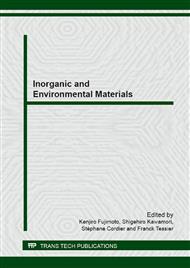p.10
p.14
p.18
p.24
p.28
p.32
p.36
p.40
p.46
Insoluble Treatment with Dolomite-Based Material for the Fluoride Ion
Abstract:
This study evaluated the fluorine removal capacity of half-burnt dolomite and examined the removal mechanism. As the result of examining the burning conditions of dolomite, it was found that dolomite burnt at 1023 K for 4 h has the highest performance. It turned out the fluorine removal mechanism that CaCO3 does not contribute to reaction and that fluorine is sorbed with hydration of MgO. As the result of comparing removal capacity by changing the initial pH of fluorine solutions, it was found that performance is reduced in the strong alkaline solution.
Info:
Periodical:
Pages:
28-31
Citation:
Online since:
June 2014
Authors:
Keywords:
Price:
Сopyright:
© 2014 Trans Tech Publications Ltd. All Rights Reserved
Share:
Citation:


